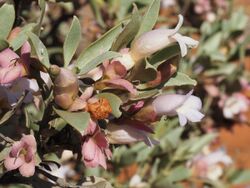Biology:Eremophila tietkensii
| Eremophila tietkensii | |
|---|---|

| |
| Eremophila tietkensii leaves and flowers | |
| Scientific classification | |
| Kingdom: | Plantae |
| Clade: | Tracheophytes |
| Clade: | Angiosperms |
| Clade: | Eudicots |
| Clade: | Asterids |
| Order: | Lamiales |
| Family: | Scrophulariaceae |
| Genus: | Eremophila |
| Species: | E. tietkensii
|
| Binomial name | |
| Eremophila tietkensii | |
| Synonyms[1] | |
|
Eremophila latrobei var. tietkensii (F.Muell. & Tate) Ewart & P.H.Jarrett | |
Eremophila tietkensii is a flowering plant in the figwort family, Scrophulariaceae and is endemic to Australia . It is a rounded to flat-topped shrub with grey-green leaves, usually pinkish-purple sepals and mauve, pink or lilac-coloured petals. It is mostly found in Western Australia but also occurs in the far west of the Northern Territory.
Description
Eremophila tietkensii is a rounded or flat-topped shrub which grows to a height of between 0.6 and 2.5 m (2 and 8 ft) with its branches and leaves covered with a layer of fine grey hairs pressed against the surface. The leaves are arranged alternately, well spaced along the branches, grey-green and have a flattened stalk that is 6–12 mm (0.2–0.5 in) long. The leaf blade is lance-shaped to egg-shaped, mostly 30–72 mm (1–3 in) long, 6–17 mm (0.2–0.7 in) wide and has a smooth surface.[2][3]
The flowers are borne in groups of up to 4 in leaf axils on a hairy stalk which is usually 6.5–14 mm (0.3–0.6 in) long. There are 5 overlapping, elliptic to lance-shaped, green or pinkish-purple sepals which are mostly 7.5–15 mm (0.3–0.6 in) long. Both surfaces of the sepals are hairy, especially around the edges and are usually more hairy on the outer surface. The petals are 22–28 mm (0.9–1 in) long and are joined at their lower end to form a tube. The petal tube is pale lilac to pale mauve or pink on the outside and white with purple spots inside the tube. The outer surface of the petal tube is slightly hairy but the inner surface of the lobes is glabrous while the inside of the tube is filled with long, woolly hairs. The 4 stamens are fully enclosed in the petal tube. Flowering occurs between April and October and the fruit which follow are dry, woody, oval to conical in shape with a distinct point and 6–7 mm (0.2–0.3 in) long.[2][3]
Taxonomy and naming
Eremophila tietkensii was first formally described by Ferdinand von Mueller and Ralph Tate in 1890 from specimens collected on the 1889 expedition of William Tietkens in the Northern Territory.[4][5] The description was published in Transactions and proceedings and report, Royal Society of South Australia.[6][7] In 1928, Alfred James Ewart and Phyllis Heather Jarrett considered it to be a variety of Eremophila latrobei, publishing their report in Proceedings of the Royal Society of Victoria[8] but after examining the original specimens and comparing them with those of E. latrobei, Robert Chinnock reverted to the original name. Chinnock's 2007 explanation was published in Journal of the Adelaide Botanic Garden.[9] The specific epithet (tietkensii) honours the explorer Tietkens.[2]
Distribution and habitat
This eremophila is widespread in Western Australia, occurring in inland areas between the Rawlinson and Barlee ranges, growing on rocky slopes, stony clay flats and undulating plains[3] in the Carnarvon, Central Ranges, Gascoyne, Gibson Desert, Great Sandy Desert, Little Sandy Desert, Murchison and Pilbara biogeographic regions.[10] It also occurs in the far south-west of the Northern Territory.[11]
Use in horticulture
In an ideal situation, E. tietkensii is a compact round shrub with grey-green, leathery leaves, masses of pinkish flowers in early spring and coloured sepals which remain after the petals have fallen. It is difficult to propagate from seeds or cuttings but grafts readily onto Myoporum rootstock. It grows best in well-drained soil in a sunny position and is drought tolerant, needing only the occasional watering during a long dry spell, however it is frost sensitive.[12]
Conservation
This species is classified as "not threatened" by the Western Australian Government Department of Parks and Wildlife.[10]
References
- ↑ 1.0 1.1 "Eremophila tietkensii". Australian Plant Census. https://biodiversity.org.au/nsl/services/apc-format/display/115733. Retrieved 14 May 2019.
- ↑ 2.0 2.1 2.2 Chinnock, R.J. (Bob) (2007). Eremophila and allied genera : a monograph of the plant family Myoporaceae (1st ed.). Dural, NSW: Rosenberg. pp. 425–427. ISBN 9781877058165.
- ↑ 3.0 3.1 3.2 Brown, Andrew; Buirchell, Bevan (2011). A field guide to the eremophilas of Western Australia (1st ed.). Hamilton Hill, W.A.: Simon Nevill Publications. p. 275. ISBN 9780980348156.
- ↑ Mueller, F.; Tate, R. (1890). "Descriptions of new species". Transactions of the Royal Society of South Australia 13: 109. https://www.biodiversitylibrary.org/page/26248824#page/117/mode/1up.
- ↑ Brown, H. Y. L.; Mueller, Ferdinand von; Tate, Ralph; Tietkens, William Henry (1891). Journal of the Central Australian Exploring Expedition, 1889, under command of W.H. Tietkens, despatched by the Central Australian Exploring and Prospecting Association, Limited, under the auspices of the Royal Geographical Society of Australasia, South Australian Branch.. C.E Bristow, Govt. Printer. p. 81. https://www.biodiversitylibrary.org/item/123122#page/85/mode/1up.
- ↑ "Eremophila tietkensii". APNI. http://id.biodiversity.org.au/instance/apni/550403. Retrieved 24 March 2016.
- ↑ von Mueller, Ferdinand; Tate, Ralph (1890). "List of Plants collected during Mr. Tietkens' Expedition into Central Australia, 1889.". Transactions and Proceedings and Report, Royal Society of South Australia 13: 109. https://www.biodiversitylibrary.org/item/84659#page/117/mode/1up. Retrieved 24 March 2016.
- ↑ "Eremophila latrobei var. tietkensii". APNI. http://id.biodiversity.org.au/instance/apni/548054. Retrieved 24 March 2016.
- ↑ Chinnock, Robert J. (2007). "Eremophila tietkensii F.Muell. & Tate (Myoporaceae), a misinterpreted species". Journal of the Adelaide Botanic Garden 21: 1–3. http://www.environment.sa.gov.au/files/assets/public/journal_articles/jabg21p001_chinnock.pdf. Retrieved 24 March 2016.
- ↑ 10.0 10.1 "Eremophila tietkensii". FloraBase. Western Australian Government Department of Parks and Wildlife. https://florabase.dpaw.wa.gov.au/browse/profile/23997.
- ↑ "Eremophila tietkensii". Northern Territory Government, eflora online. http://eflora.nt.gov.au/factsheet?id=24238. Retrieved 24 March 2016.
- ↑ Boschen, Norma; Goods, Maree; Wait, Russell (2008). Australia's eremophilas : changing gardens for a changing climate. Melbourne: Bloomings Books. pp. 179–180. ISBN 9781876473655.
Wikidata ☰ Q24190209 entry
 |


